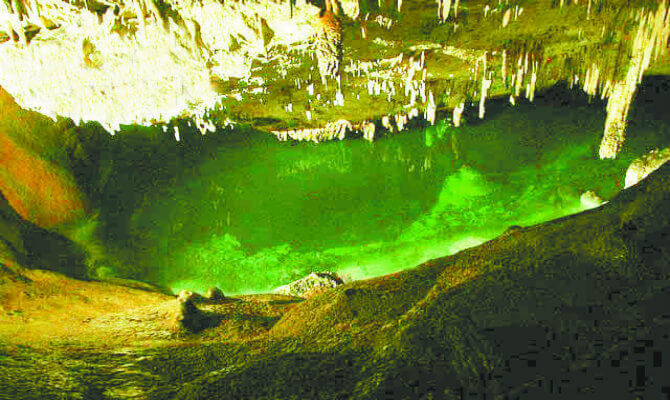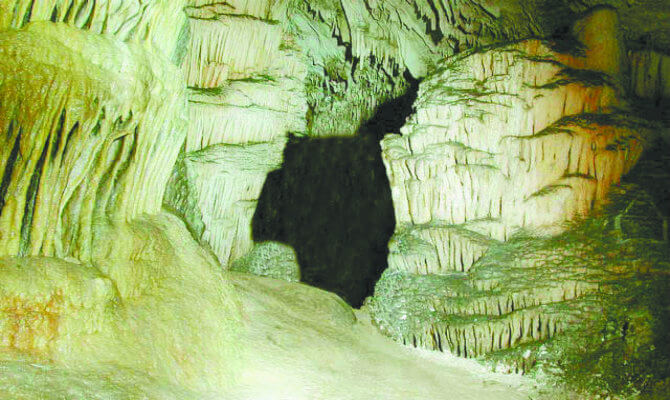Do you know…About Bermuda’s Caves, Admiral Sir David Milne and a 600,000- year-old Stalagmite?
By Horst Augustinovic
Bermuda probably has more caves per square mile than anywhere else in the world. These caves are located in the older rocks close to the current sea level, and were formed during periods of low water levels during glaciation cycles of the current ice age. These cycles occur on 40,000 to 100,000-year time scales and we are now in an interglacial period following the end of the last ice age some 10,000 years ago.
As Bermuda emerged upward from the ocean during these interglacial periods, the downward drag of water in dunes and depressions found weak pockets of limestone between the lower rocks, and these were eventually flushed out. The lowering water level then allowed air into these newly formed caves, causing the formation of drip-rock and in time, the formation of stalagmites and stalactites.
Made of calcium carbonate, Spelothems grow as long as there is dripping water in an air-filled cave and become Stalagmites if growing from the floor and Stalactites if growing down from the ceiling. When they join, they become columns or pillars. Many caves that are now completely filled with water also contain Spelothems, indicating that they were once above sea level.
A major group of caves is located to the east of Harrington Sound, the largest being Crystal Cave. Admiral’s Cave, another large cave, is located between Blue Hole Hill and Grotto Bay and almost entirely above sea level. It is called Admiral’s Cave after Admiral Sir David Milne, who in 1819 removed a massive stalagmite from the cave and presented it to his friend Professor Robert Jameson of the University of Edinburgh for the College Museum.
The 1888 Bermuda Pocket Almanack contains the following report: “A splendid stalagmite cut from the Walsingham Caves is now in the Museum, Edinburgh, and has attached to it the following description: ‘Stalagmite of Carbonate of Lime Sawn from the Floor of a Cave in the Island of Bermuda’. The stalagmite was 11 feet 3 inches tall and weighed 3-1/2 tons.
In 1863 – 44 years after his father had removed the stalagmite – the Admiral’s son, Admiral Sir Alexander Milne, visited the cave where he had witnessed the removal as a boy, and found that 5 drips had formed small knobs of new matter on the stump of the stalagmite. He calculated that the new matter amounted to about 5 cubic inches and, as the stalagmite consisted of approximately 44 cubic feet – or 76,000 cubic inches – concluded that it would have taken 600,000 years to form the stalagmite that his father had removed from the cave. This calculation assumed that the deposits occurred at exactly the same rate as in the previous 44 years, something that is highly unlikely.
When HMS Challenger surveyed Bermuda in 1873, Sir C.W. Thomson had the stump of the stalagmite removed and also sent to the University of Edinburgh. According to David Summers, President of Crystal Caves, tragedy befell the Bermuda stalagmite in 1973 when the museum was being altered. Rather than remove the stalagmite from an upper floor, it was allowed to fall through several floors and was smashed to pieces.
Comments: netlink@link.bm








